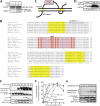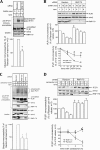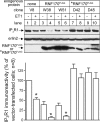RNF170 protein, an endoplasmic reticulum membrane ubiquitin ligase, mediates inositol 1,4,5-trisphosphate receptor ubiquitination and degradation
- PMID: 21610068
- PMCID: PMC3129221
- DOI: 10.1074/jbc.M111.251983
RNF170 protein, an endoplasmic reticulum membrane ubiquitin ligase, mediates inositol 1,4,5-trisphosphate receptor ubiquitination and degradation
Abstract
Inositol 1,4,5-trisphosphate (IP(3)) receptors are endoplasmic reticulum membrane calcium channels that, upon activation, are degraded via the ubiquitin-proteasome pathway. While searching for novel mediators of IP(3) receptor processing, we discovered that RNF170, an uncharacterized RING domain-containing protein, associates rapidly with activated IP(3) receptors. RNF170 is predicted to have three membrane-spanning helices, is localized to the ER membrane, and possesses ubiquitin ligase activity. Depletion of endogenous RNF170 by RNA interference inhibited stimulus-induced IP(3) receptor ubiquitination, and degradation and overexpression of a catalytically inactive RNF170 mutant suppressed stimulus-induced IP(3) receptor processing. A substantial proportion of RNF170 is constitutively associated with the erlin1/2 (SPFH1/2) complex, which has been shown previously to bind to IP(3) receptors immediately after their activation. Depletion of RNF170 did not affect the binding of the erlin1/2 complex to stimulated IP(3) receptors, whereas erlin1/2 complex depletion inhibited RNF170 binding. These results suggest a model in which the erlin1/2 complex recruits RNF170 to activated IP(3) receptors where it mediates IP(3) receptor ubiquitination. Thus, RNF170 plays an essential role in IP(3) receptor processing via the ubiquitin-proteasome pathway.
Figures






Similar articles
-
A Point Mutation in the Ubiquitin Ligase RNF170 That Causes Autosomal Dominant Sensory Ataxia Destabilizes the Protein and Impairs Inositol 1,4,5-Trisphosphate Receptor-mediated Ca2+ Signaling.J Biol Chem. 2015 May 29;290(22):13948-57. doi: 10.1074/jbc.M115.655043. Epub 2015 Apr 16. J Biol Chem. 2015. PMID: 25882839 Free PMC article.
-
Binding of the erlin1/2 complex to the third intralumenal loop of IP3R1 triggers its ubiquitin-proteasomal degradation.J Biol Chem. 2022 Jun;298(6):102026. doi: 10.1016/j.jbc.2022.102026. Epub 2022 May 11. J Biol Chem. 2022. PMID: 35568199 Free PMC article.
-
An endoplasmic reticulum (ER) membrane complex composed of SPFH1 and SPFH2 mediates the ER-associated degradation of inositol 1,4,5-trisphosphate receptors.J Biol Chem. 2009 Apr 17;284(16):10433-45. doi: 10.1074/jbc.M809801200. Epub 2009 Feb 24. J Biol Chem. 2009. PMID: 19240031 Free PMC article.
-
When worlds collide: IP(3) receptors and the ERAD pathway.Cell Calcium. 2009 Sep;46(3):147-53. doi: 10.1016/j.ceca.2009.05.002. Epub 2009 Aug 25. Cell Calcium. 2009. PMID: 19709743 Free PMC article. Review.
-
Membrane Protein Quantity Control at the Endoplasmic Reticulum.J Membr Biol. 2017 Aug;250(4):379-392. doi: 10.1007/s00232-016-9931-0. Epub 2016 Oct 14. J Membr Biol. 2017. PMID: 27743014 Free PMC article. Review.
Cited by
-
Pathophysiological involvement of host mitochondria in SARS-CoV-2 infection that causes COVID-19: a comprehensive evidential insight.Mol Cell Biochem. 2023 Jun;478(6):1325-1343. doi: 10.1007/s11010-022-04593-z. Epub 2022 Oct 29. Mol Cell Biochem. 2023. PMID: 36308668 Free PMC article. Review.
-
Revealing the Molecular Mechanisms of Alzheimer's Disease Based on Network Analysis.Int J Mol Sci. 2021 Oct 26;22(21):11556. doi: 10.3390/ijms222111556. Int J Mol Sci. 2021. PMID: 34768988 Free PMC article.
-
Transmembrane Protein pUL50 of Human Cytomegalovirus Inhibits ISGylation by Downregulating UBE1L.J Virol. 2018 Jul 17;92(15):e00462-18. doi: 10.1128/JVI.00462-18. Print 2018 Aug 1. J Virol. 2018. PMID: 29743376 Free PMC article.
-
Role of ERLINs in the Control of Cell Fate through Lipid Rafts.Cells. 2021 Sep 13;10(9):2408. doi: 10.3390/cells10092408. Cells. 2021. PMID: 34572057 Free PMC article. Review.
-
The glycoprotein quality control factor Malectin promotes coronavirus replication and viral protein biogenesis.bioRxiv [Preprint]. 2024 Jul 16:2024.06.02.597051. doi: 10.1101/2024.06.02.597051. bioRxiv. 2024. PMID: 38895409 Free PMC article. Preprint.
References
-
- Wojcikiewicz R. J., Xu Q., Webster J. M., Alzayady K., Gao C. (2003) J. Biol. Chem. 278, 940–947 - PubMed
Publication types
MeSH terms
Substances
Grants and funding
LinkOut - more resources
Full Text Sources
Molecular Biology Databases
Miscellaneous

